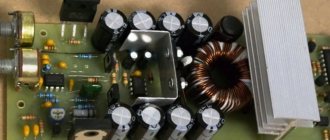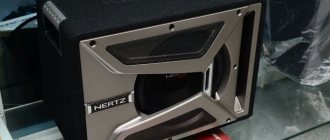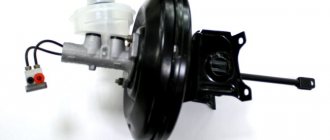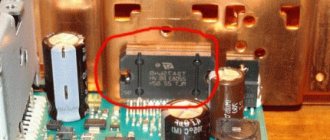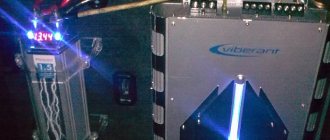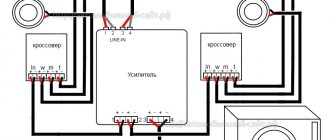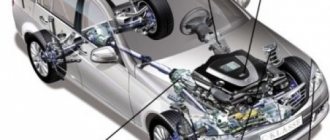Choosing a car audio amplifier (TOP best models)
A car amplifier is one of the main components of the music system in a car. Receives the signal that comes from the linear output of the head unit, improves the final sound quality and increases the volume. They differ in design, technical characteristics and functionality. Therefore, a sound amplifier for a car is selected individually for a specific radio model and subwoofer parameters, the number of speakers and the driver’s musical preferences.
The best speakers for the car
For high-quality sound reproduction, the car is equipped with component speaker systems. To know which speakers to choose for your car, you need to understand their main characteristics. There are several main parameters:
- Power
- Power limit
- Coil resistance
- Frequency range
- Sensitivity
What power speakers should you choose for your car? Loudspeaker power plays a subjective role. Some car enthusiasts believe that the higher the volume, the better the sound. This is not entirely true. The quality of sound reproduction largely depends on the following factors:
- Placing speakers in the car
- Proper noise and vibration insulation
- Radio and amplifier parameters
You can find out which speakers are best for your car by carefully reading the product documentation. Some manufacturers indicate enormous speaker power, reaching up to a kilowatt, but this peak power is also overestimated. You need to be guided by the nominal parameter, which determines the quality of sound reproduction. Which speakers are best placed in the speakers is determined by the output power of the sound reproduction system. The total power of the speakers operating on one channel should exceed the power of the amplifier or radio by 15-20%. If it is less, the sound will be reproduced with distortion. The coil resistance can be 2, 4 or 8 ohms. Other values are rare. The speaker impedance is indicated in the documentation for the amplifier. If a value of 4 ohms is specified, then when connecting a speaker with a lower resistance, the volume will increase. Which car speakers are best to choose also depends on the range of reproduced frequencies.
Amplifier functions
The amplifier, depending on the manufacturer and model, performs a large number of functions.
- Customize the sound using the built-in equalizer. An equalizer with a large number of settings is a privilege of premium models. Allows you to customize the sound without losing quality.;
- Filtering low-pass, mid-range and high-pass frequencies instead of crossover. An extremely useful function for car radios without a built-in crossover, it regulates the sound, “cutting off” everything unnecessary that is above a given frequency.
- Adjusting the output signal level. Using this function we balance the sound across all channels.
- Bass boost. An equalizer specifically tuned for low frequencies solves the problem of lack of bass, allowing you to make changes in the low-frequency region. Requires careful use. Flirting with this setting will result in severe sound distortion and damage to the subwoofer.
The best four-channel amplifiers in a car
Kicx QS 4.160M, black editionThe amplifier is designed to operate in class AB when connected to a channel or bridge. In the first case, it produces up to 160 W at a load of 4 ohms, in the second - up to 310. The manufacturer allows connecting two speaker systems only in a four-channel connection (320 W per channel). The appearance of the amplifier case is rustic, even deliberately rough. However, they have excellent performance in terms of distortion and channel separation. There are a total of 4 input “tulips”, and the inputs are divided into two groups, in each of which all settings are set separately - the only thing you need to do is connect the front and rear speakers to one amplifier. Each pair of channels can also be bridged - here you have a 2.1 amplifier for the front panel and a subwoofer. The presence of line outputs will allow you to connect an amplifier to all four channels by connecting the subwoofer amplifier to the cascade. For each group of channels (A and B) there is a sensitivity adjustment, a subsonic filter (0-50 Hz), there is a high-pass filter and a bimodal one. In one version, the shutdown frequency is adjustable in the range of 50-500 Hz, in the other - from 500 Hz to 5 kHz. The low-pass filter has exactly the same two modes, and for each group you can selectively activate one of the filters - this is already useful when assembling component acoustics, where one amplifier channel will be responsible for mid/high frequencies, and the other for low frequencies. frequencies. Main advantages:
minuses:
| 9.8/10 rating |
Infinity REF-704ASince Kicx is gray (i.e. black) and inconspicuous, the same Infinity attracts the eye, while avoiding cheap kitsch. Of course, they cannot measure their power: here, when connecting 4-ohm speakers, no more than 70 W are available per channel (moreover, when measuring, you can actually get 100 W with normalized THD). But if this power is enough for you and you have purchased high-quality sensitive speakers for your car, Infinity will show enough “chips”. One of them is the ability to connect directly to the radio's power outputs, although there are no separate high-level inputs. We take adapters from the terminal blocks to the “tulips” of the kit, insert them into the input lines and simply click on the input level from Lo (linear input) to Hi1 or Hi2 (high-level inputs with different sensitivities). In Hi2, the input impedance is further reduced in case the standard GU refuses to work without “seeing” the load at the output of its amplifier. Easy and convenient, and special thanks for the presence of adapters in the kit. The input channels are strictly defined as front and rear, but in fact the set of settings is identical - you can adjust the sensitivity, the frequency of turning off the high-pass filter or low-pass filter, selected arbitrarily. However, the filter band is fixed - from 32 to 320 Hz, i.e. There is no such convenience when working with component acoustics as Kicx. There are generalized outputs for connecting a subwoofer amplifier to the cascade. Another feature is the Halosonic auxiliary input, designed for Harman's own active noise cancellation system: road noise is transmitted in antiphase, and the speakers thus drown out surrounding sounds. Main advantages:
minuses:
|
|
It is also useful to read: Rating of the 18 best car speakers 2020
Pioneer GM-D8604What if “we were cheaper and more powerful”? Then, with the "yes, I'll still listen to MP3s" waved, let's look at Class D amplifiers. The GM-D8604 is capable of delivering up to 100W per channel with a 4-ohm speaker and is capable of more (claimed power in this mode is 200W ), but the SOI curve up to this mark increases sharply and the sound quality decreases significantly. For two-ohm speakers, the “listening” threshold is within 150 W per channel. The connection is simple and straightforward - the line input connectors are located in the center, and the controls for each pair are located at the ends, so you won't get confused. Each pair of channels can operate in a bridge (link in 2.1 format), but consider one feature that is barely noticeable due to illegible markings: the polarity of the block does not change as usual (plus-minus-plus-minus), but symmetrically (plus-minus minus plus). The set of corrections in each pair is minimal - gain, selection of crossover mode HPF / linear / LPF), filter cut-off band. You can also find an input selector switch: in the 2CH position, only one pair of linear inputs is turned on and for each pair of channels the loudspeaker is connected to a bridge or a 2-1 circuit is assembled; in 4CH mode, respectively, all inputs work. It is possible to connect to linear inputs as high-level inputs; there are no separate operating mode switches. Main advantages:
minuses:
| 9.0 / 10 rating |
About the selection criteria
- Amplifier type. There are 2 types of amplification devices - monoblocks and multi-channel (up to 8 channels). The first ones are used for 1 subwoofer and are cheaper. An amplifier for a car with several channels is installed in more complex music systems consisting of several speakers and a subwoofer.
- Rated power. This is a characteristic when choosing equipment for amplification, on which unscrupulous manufacturers speculate. Instead of the rated power, the maximum power is indicated on the product packaging; its real value is overestimated, explaining this by a large number of measurement methods. The sound amplifier does not require super power. The recommended value for one channel is 75 - 120% of the total power. A weaker car amplifier will not be able to control the speakers. A device that is too powerful will negatively affect the sound quality.
- THD coefficient. Total Harmonic Distortion is translated as harmonic distortion coefficient. The measurement is carried out at a frequency of 1 kHz. Indicates signal distortion after passing through blocks of amplification equipment. THD is indicated as a percentage. The smaller it is, the cleaner and better quality the sound of the music system will be.
- Characteristics of channel separation. The characteristic is indicated in decibels. Indicates the degree of isolation of channels from each other. The higher the value, the better the amplification device works.
- Damping factor. Indicates the level of membrane damping inertia between pulses. The higher the number, the better the sound.
- Class. Classes of car amplifiers: A, AB, B, C, D, etc. - differ in performance. Class A includes the best amplifier models with low sound distortion, but high power consumption and high heat generation. Rarely used in machines due to low efficiency. The efficiency is 20%.
Classes B and C are the exact opposite. They provide high volume sound reproduction and are characterized by increased thermal stability. The main disadvantage is strong distortion.
Class AB is a compromise between devices A and B. The equipment is popular due to its better ratio of efficiency and distortion level. Recommended for purchase.
There is digital class D. Most models have a narrow specialization, amplifying only low-frequency signals. However, universal broadband devices with richer functionality are more often found on the market.
Frequency range and signal-to-noise ratio are secondary technical characteristics. Most models have values high enough to reproduce sound. It is better to pay additional attention to the overall build quality and the presence of durable and long cables included.
High-quality multifunctional amplifiers are heavy, since their housing contains a large and heavy radiator, which is responsible for dissipating heat. However, simpler but high-quality equipment can have compact overall dimensions.
Amplifier characteristics.
Amplifier class . Despite the large number of types of amplifiers (A, B, C, D, AB), AB and D classes are now most widespread.
AB - have good output signal quality, but low efficiency (the best indicator is 65%, usually much less). Other disadvantages of this class stem from the low efficiency: low output power (for 100 W of consumed power the output will be only 50) and large dimensions (
50% of the power is released as heat in the high-power transistors of the output stage and this heat must be dissipated using radiators).
Class D amplifiers do not use high-power transistors. With the same power consumption as AB-class, such an amplifier will have higher output power and much smaller dimensions. The efficiency of D-class amplifiers reaches 95%. Unfortunately, with the same power as an AB-class amplifier, the cheapest D-class amplifier will cost significantly more and produce lower-quality sound. But D-class amplifiers can be very powerful with small sizes: with the help of such an amplifier you can connect the most powerful subwoofer to your car audio system.
Number of channels . This, simply put, is the number of outputs, each of which can be connected to a speaker.
Although it is possible to connect one more powerful speaker to two channels using a “bridge circuit”, and to connect two speakers to one channel, calculating the total resistance using the appropriate formula.
Single-channel amplifiers (monoblocks) are usually designed to connect a subwoofer to an existing audio system. Accordingly, when choosing such an amplifier, those parameters that are useful when connecting a subwoofer are important. The presence of a high-pass filter in a monoblock is not necessary (there is no point in connecting high-frequency tweeters to it), but the presence of a low-pass filter is almost mandatory. The reproduced frequency range in such amplifiers is usually shifted downward, and the maximum frequency rarely exceeds 250 Hz. To connect powerful subwoofers, it is desirable to have an ultra-low frequency filter (subsonic) in the amplifier to “cut off” frequencies below 20 Hz that are inaudible to the ear, but harmful to both the equipment and the human body. Adjusting the bass level will also be useful, especially if it is not included in the standard radio.
Two-channel amplifiers are a more versatile option. They can be used both to connect two speakers, and to connect one powerful speaker (subwoofer) via a bridge circuit. They amplify in the entire audible range: 20-20,000 Hz. Accordingly, they are usually equipped with both low-pass and high-pass filters.
Three-channel amplifiers are designed to connect two speakers and a subwoofer. Such amplifiers often have additional features for working with a subwoofer, such as a subsonic filter or bass adjustment.
Four-channel is the most universal option, most often used to build an entire audio system. It consists of two two-channel amplifiers combined in one housing. Most often, each amplifier has its own crossover (a set of separate filters), which allows the amplifier to be used both for connecting four speakers and for connecting two speakers and a subwoofer. However, in some models, to reduce the price, one pair of channels is designed to reproduce high frequencies, the other - low frequencies (usually designated as “front” for high frequencies and “rear” for low frequencies). Accordingly, there may not be a high-pass filter, for example, on the rear pair.
Five-channel ones are designed to connect four speakers and a subwoofer.
Rated output power. One of the most important indicators of an amplifier. Manufacturers understand this and often try to mislead the buyer by indicating on the amplifier housing numbers that either relate to peak power, or consumption, or have nothing to do with the real power of the device.
Rated output power (RMS) is the power at which the amplifier can operate for an extended period of time (minimum 1 hour). Peak power is the power that an amplifier can produce for a short time; long-term operation at such power is guaranteed to damage the amplifier.
The output power of the amplifier is inversely proportional to the internal resistance of the connected speakers: when the speaker impedance doubles, the power also drops by half. Therefore, the rated power must be given with a mention of the internal resistance (impedance) of the connected speakers.
If two speakers are connected to one channel at once, their resistance changes - for a series connection it is added up, for a parallel connection it is calculated using the formula (R1*R2)/(R1+R2).
If you are going to use a pair of channels to drive a subwoofer in bridged mode, make sure that the amplifier allows this connection and find out what the minimum speaker impedance is for this connection.
The minimum and maximum reproducible frequency usually covers the entire audible range - from 20 to 20,000 Hz. Exceeding these limits in both directions occurs, but has no practical meaning. Rather, a range of 10-50,000 Hz is indicated on the amplitude-frequency response scale of some amplifiers as evidence that in the audible range (20 Hz-20 kHz) the frequency response is flat and the signal is amplified regardless of frequency. In monoblocks designed exclusively for connecting subwoofers, the maximum frequency is often reduced to 250-300 Hz. This is normal; there is no need for the subwoofer to reproduce higher frequencies.
For quality connoisseurs, indicators such as harmonic distortion and signal-to-noise ratio .
The best car amplifier manufacturers
The rating of high-quality car amplifiers includes music equipment from the following manufacturers:
- Alpine (Japan);
- Kenwood (Japan);
- Focal (France);
- Pioneer (Japan);
- Kicx (USA-South Korea);
- Mosconi (Italy);
- Helix (Germany).
The best single-channel models
Pioneer GM-D9601
The single-channel sound amplifier from the Japanese manufacturer has a classic cast housing with mounting “claws” and a simplified installation diagram. Allows you to get the most out of your subwoofer. Has a wired remote control for adjusting the bass. The advantage is the rated power. The equipment is capable of delivering 800 W with a resistance of 2 ohms. Has a low pass filter and short circuit protection. Refers to digital class equipment. Weight GM-D9601 – 3.3 kg.
+ High-quality low-pass filter.
+ Compact dimensions and convenient installation.
+ Sufficient level of rated power.
Kicx QS1000
Monoblock with wide functionality and corresponding cost. The rated power indicator (at 2 Ohms) is 1500 W. The damping factor is more than 100. It has a multi-level protection system against voltage drop, overheating and short circuit.
+ Availability of a modern security system.
+ Automatic filtering of low and infra-low frequencies.
Helix Xmax 1.2
Mono amplifier from a German manufacturer with a simple design and compact overall dimensions. Designed for installation in a car with a powerful subwoofer. A standard short-circuit protection system with light indication will ensure long-term operation of the equipment. The amplifier model has a built-in crossover that removes midrange and bass. The rated power of the Xmax 1.2 mono amplifier is 350 W (4 ohms) and 550 W (2 ohms).
+ Sufficient power level.
— Not the best sound quality.
The best two-channel car amplifier models
Pioneer GM-A5702
Two-channel audio amplifier in an aluminum housing, which is coated with powder paint. Belongs to class AB. Has a powerful bass register. Produces high-quality sound, despite sufficient power. After turning on Bass Boost, the sound of the speakers becomes richer and brighter.
What is an amplifier for?
Many car owners cannot enjoy loud music while traveling. At first glance, the problem can be solved by buying a good radio and speakers. But again, unnecessary interference arises, you just have to turn up the volume. Car enthusiasts who do not understand acoustic systems will blame the speakers, which, in their opinion, were not of such quality, because the radio has sufficient power.
In fact, the power indicated by the radio manufacturer is maximum and is provided for a short period of time, and this is not enough to listen to loud music, which is what causes squeaks, noises or wheezing. Also, the signal going from the radio to the speakers gets distorted. To eliminate these distortions, as well as strengthen the radio signal, a car audio amplifier is needed.
If we talk about the design of the amplifier, it consists of four components. To generate and regulate voltage, the device has a power supply. There are also two blocks that process input and output signals and a driver. First, the signal enters the input signal block, here the signal is “checked” for the presence of distortions and their removal. After which the driver will divide the received signal and amplify it. The signal will now be passed to the output signal block.
Where and how best to install
When installing such a device in a car, the main thing is to choose the right place. This place should provide not only protection from moisture and the possibility of mechanical damage, but also should allow the amplifier to cool. At the same time, the amplifier should not create inconvenience and discomfort for both the driver and his passengers. It is also necessary to take into account that wires will need to be pulled to the device, which must be positioned correctly, otherwise white noise will occur.
Now you can consider the main places where you can install the amplifier, and all the advantages and disadvantages of a certain location of the device. Quite often they are installed under the front seat. This way the unit will be located quite close to the energy source and sound source, which is a significant plus. Also, such an installation will not “steal” useful space in the car. But there will not be enough air circulation and space under the car seat, which will lead to overheating. In addition, the unit will be located far from the speakers and subwoofer.
In sedans, the amplifier can be installed under the shelf in the trunk or under the rear window. This will ensure that the device receives enough air without causing overheating. Since there is enough space, a high-power unit can be installed, and the vehicle owner will have access to both the device and the wiring. However, such an installation will not take up the required space; it will simply make the back wall a little thicker. The main disadvantage here may be the thin back wall. Due to this, the device cannot be securely fastened, and rattling or vibration may occur when driving on uneven roads. Also, the case will constantly beat, which will subsequently lead to distortion of the reproduced sound or even to a short circuit.
It will be quite convenient to mount the unit on one of the side walls of the trunk. This method is very convenient both for installing the amplifier itself and for connecting the wiring. In this case, the device will not take up useful space in the trunk and will not spoil the appearance, and it is also worth noting that air will always pass to the unit and will not allow it to overheat. But in this case, the amplifier will be far from the power source and sound source, which is a disadvantage.
Those who like to stand out and emphasize their individuality can install the unit on the trunk lid. This method will allow the device to receive enough air without stealing free space. However, this option is not very reliable. Firstly, the trunk lid is not thick enough, so the screwed parts will become loose and rattle over time. Also, because of this, the trunk lid may be deformed and it will not close tightly. Well, don’t forget that moisture can get into the device. In addition, such an installation is very difficult, and difficulties arise with connecting the wiring. Wires can crack due to temperature changes, resulting in a short circuit.
A fairly practical way is to install it on the back of the rear seat. This is a fairly simple method that will not take much effort, and in this case the unit will receive the necessary air and will not overheat. The amplifier will be close to the speakers, will not take up useful space and will be securely fastened due to the metal panel on the seats. The disadvantages of this method include the fact that the unit will be located far from sound and power sources, and kinks may also occur on the wires.
Types of car audio amplifiers
First of all, such units can be classified into classes. The clearest sound is provided by A-class devices. But they have a small percentage of efficiency, which varies between 20-30%. Therefore, most of the sound will be lost. Also, such options have a high cost. Due to this, they are not very popular among drivers.
The next class is B. Compared to the previous version, there is a little more power here, but the sound has some distortion. For this reason, this option is not used in cars. There is also a C-class, which has high efficiency, but at the same time greatly distorts the sound.
The modern version, which has digital signal processing, belongs to the D-class. This option is compact in size, does not distort the sound much and has high efficiency.
But still, AB-class models are more popular. They are analog devices that combine A-class sound frequency and B-class power. But such models have quite large dimensions and become very hot during operation.
In addition, amplifiers are classified by the number of channels. Single-channel models are used with subwoofers. They have quite high power, but the sound quality is not high. Such models in most cases require a filter for high and low frequencies. This will remove sounds that are not perceived by the human ear, however, they have a detrimental effect on equipment, as well as human health.
Models with three or two channels allow you to connect two speakers and a subwoofer. They can function perfectly with low impedance loads, and thanks to the bridge connection, high power levels are obtained.
The four-channel option is the most popular among users. Such models are a power supply that has outputs to two two-channel units. With their help, you can make various connections, for example, four speakers or two speakers and one subwoofer, as well as two subwoofers. Therefore, such models are not only practical to use, but also allow you to enjoy high-quality sound of your favorite music.
There are also options with five and six channels, but they are not very popular among buyers.
Advantages of a car amplifier
Superb sound quality. Using a stereo amplifier will allow you to optimally tune the sound of your car system. Connecting a car amplifier through a crossover improves sound perception over the entire audio frequency range.
You need to consider the fact that the on-board voltage in the car is not always sufficient to provide the output power of the audio amplifier. In particular, this occurs with subwoofers; the output amplitude voltage of the power amplifier cannot adequately drive powerful low-frequency speakers.
This problem can be solved by using an amplifier with high-capacity electrolytic capacitors, which allow the accumulation of the necessary discharge and make the bass extremely rich and high-quality. You can find out how to connect a capacitor to a subwoofer here. Most car owners install additional subwoofers on their cars, which improves the quality of the standard audio system.
To connect a subwoofer, you need to use an additional amplifier, which will allow you to drive even a powerful subwoofer. Most car audio amplifiers used today have additional outputs for the subwoofer and speakers in the car. That is why, by installing high-quality amplifiers in your car, you will completely solve the problem of organizing high-quality sound.
The car owner can improve the sound quality of the standard audio system without replacing the head player and speakers. You just need to install an additional four-channel amplifier, which is compact in size and boasts high power. In most cases, installing and connecting a four-channel amplifier is not difficult and can be done independently.
At the same time, it should be noted that most standard audio systems in a car have mediocre quality speakers, so if you want to get truly high-quality sound in your car, we recommend installing not only an additional amplifier, but also replacing the existing standard speakers.
In this case, the car owner has ample opportunities to position the speakers and select their components. Many people limit themselves to installing spaced front speakers with tweeters and tweeters.
In this case, when using such an acoustic circuit, a four-channel amplifier will be simply necessary for you. On sale, car owners can find compact models that can easily be installed in the glove compartment or inside the center console.
Classes of car amplifiers
First of all, I would like to talk about the classes of amplifiers; at the moment there are a large number of them, but we will look at the two main ones, which are very often found in car audio systems. If you are interested in this topic in more detail, at the end of the article there is a video that talks about all the classes of car amplifiers that are now available.
- Class AB amplifier. These amplifiers have very good sound quality and, when connected correctly, are reliable and durable. If an AB class amplifier has a lot of power, then it has very large dimensions; these amplifiers have a low efficiency of about 50-60%, i.e., if 100 W are supplied to them. energy, then a current of 50-60 watts will reach the speakers. The rest of the energy simply turns into heat. AB class amplifiers should not be installed in a closed space, otherwise in the heat it may go into protection.
- Class D amplifier (digital amplifier). Class D is mainly found in monoblocks (single-channel amplifiers), but there are also four and two-channel ones for connecting acoustics. This amplifier has many advantages. Compared to the AB class, with the same power, it has very compact dimensions. The efficiency of these amplifiers can reach 90%, it practically does not heat up. D class can operate stably at low ohm loads. Everything would be fine, but the sound quality of these amplifiers is inferior to class AB.
In conclusion, we will draw a conclusion for this section. If you are chasing sound quality (SQ), then it would be better to use class AB amplifiers. If you want to build a very loud system, then it is better to opt for class D amplifiers.
Car speaker configurations
When choosing an amplifier, you must remember that three-channel amplifiers are designed to work with one pair of speakers and an additional subwoofer. A four-channel amplifier can simultaneously drive a subwoofer and two pairs of speakers. In rare cases, five-channel stereo systems with many speakers are used in the car.
We build an audio system in a car from scratch
When planning and installing an audio system in a car, you first need to decide on its components and power ratings. You should remember that using a powerful amplifier will allow you to improve the sound quality at low volumes. Therefore, it is recommended to take the amplifier into the car with a small power reserve. Additionally, you must consider the volume of the car's interior.
Therefore, for a compact city baby, you can choose the audio system power slightly lower than for a full-size station wagon or SUV. In this case, the optimal choice would be to use an amplifier with a power of 75 W per channel for an SUV and 50 W for a small car. For lovers of bass and loud music, we can recommend choosing systems with a power of 100-200 W per channel.
Subwoofer installation
It is the low frequencies, or as they are also called bass, that play almost the main role in the perception of the sound picture. This is why many car owners decide to install special speakers in their cars that are responsible for reproducing low frequencies.
If you are happy with the power and quality of your car's existing stereo speakers and simply want to add a subwoofer, you can use a single-channel amplifier that is designed to drive the subwoofer exclusively. In this case, you need to choose an amplifier power in the range from 50 to 200 W per channel.
What speakers to put in the car
Car speakers are usually divided into three groups:
- Wideband acoustics
- Coaxial speakers
- Component systems
Wideband acoustics consists of a single speaker that reproduces almost the entire range of sound frequencies. The best car speakers have a lower limit of about 40-50 Hz and up to 12-15 kHz in high frequencies. Car audio systems with one speaker are the easiest to install. The design of the diffuser of a wideband speaker does not allow for good reproduction of low and high frequencies at the same time, therefore, at the edges of the audio range there are small blockages in the frequency response. Such acoustics can create an even sound background in a car, but are not suitable for high-quality music playback.
Coaxial car systems are in demand among most car enthusiasts. They provide good playback quality and are easy to install. Structurally, such a system is a broadband loudspeaker, in the central part of which, on a special bar, a small-sized high-frequency speaker is installed. In some models, the number of central heads can reach three, when in addition to the high-frequency tweeter, there are two mid-frequency heads on the central speaker. In this case, the acoustics are connected to the amplifier not directly, but through a crossover, which divides the entire sound range into bands according to the number of speakers. Which speakers are best to put in a car depends, first of all, on the requirements for playback quality.
Purpose and technical parameters
Why do you need an amplifier in a car? Its main purpose is to improve sound quality and increase volume. This is achieved by increasing the amperage of the audio signal from the audio system. Thanks to this, the speakers produce the clearest and strongest sound possible. Modern car speaker systems are equipped with built-in amplifiers, but the power of their power supplies is sometimes not enough to produce high-quality sound.
Car amplifiers can have a different number of channels. They are used depending on the number of connected speakers and subwoofers. In addition, there is an analog (tube car amplifier) with low power, high-quality sound amplification, low efficiency, and digital with high power, high efficiency, and insufficient quality. A digital car audio amplifier for cars allows you to select and remember the frequency characteristics for a specific speaker of the speaker system.
The main characteristics of a car audio amplifier are the output power and the range of output frequencies. Particular attention should be paid to power. You need to select with some reserve. This parameter is the main criterion for selection.
You need to consider the rear and front speakers when choosing power. For speakers it should be in the range from 75 to 100 W, for subwoofers - from 100 to 300 W. Using the frequency characteristics, you can customize the sound of the acoustics taking into account the characteristics of the car's interior. They make it possible to make frequencies that interact with interior elements inside the car weaker. If the interior components absorb sounds, they can be strengthened with frequency characteristics (the author of the video is Autosound in the Province).
Amplifier power.
Power is one of the most important parameters. First, let's figure out what the difference is between rated and maximum power. The latter, as a rule, is indicated on the amplifier body; it does not correspond to reality and is used as a duct. When purchasing, you need to pay attention to the rated power (RMS). You can view this information in the instructions; if you know the speaker model, you can find the characteristics on the Internet.
Now a few words on how to select the power of the amplifier and speakers. Want to know more about choosing speakers? read the article “how to choose car speakers.” Car speakers also have a rated power; in the instructions it is designated as RMS. That is, if the acoustics have a rated power of 70 W. Then the rated power of the amplifier should be approximately the same, from 55 to 85 W. Example two, what amplifier is needed for a subwoofer? If we have a subwoofer with a rated power (RMS) of 300W. The amplifier power should be 250–350 W. Conclusion for the section. A lot of power is, of course, good, but you shouldn’t chase it, because there are amplifiers with less power, but they play much better and louder than inexpensive ones but with some sky-high performance.
Criterias of choice
To get high-quality sound, you should choose the right music amplifier for your car. To do this, you need to know what parameters should be taken into account and what to pay attention to.
Gain class
Based on the level of signal distortion and taking into account efficiency, audio amplifiers for car speakers are divided into amplification classes:
- And class. They have a low efficiency of up to 20%, but allow you to get sound with the least distortion, but at the same time they consume and emit a lot of heat. Due to their low power and high noise in the cabin, they are rarely installed in cars.
- To class. These devices are more powerful than the previous class, but produce a more distorted signal. They have better thermal stability and high efficiency in sound reproduction. They are also rarely used on modern cars.
- C class. They have a high efficiency of 75%, but produce a highly distorted signal. They are not installed with Hi-Fi audio systems.
- Mixed class A/B. They have average performance between A and B: average power level, good efficiency, low level of signal distortion.
- D class. Refers to digital devices. These are compact, powerful devices that produce relatively clear sound. Previously they were used to enhance low frequencies, but now broadband devices are more often used. They are more expensive than A/B class devices and are still inferior to them in popularity.
Auto power amplifier for speakers
Among the classes of car amplifiers, the most popular is the mixed class A/B.
Number of channels
Audio devices that are equipped with a built-in car amplifier power supply and processor are used with a different number of power channels. The best option is to use a device that provides each speaker with a separate channel. Any music track played through an amplifier has at least two channels.
Thus, amplifiers can have up to six channels, each of them has its own scope of application:
- A single channel, called a monoblock, is most often used with a subwoofer. A monoblock for a subwoofer is selected in the case of low-impedance loads up to 2 ohms; if the subwoofer is designed for loads above 4 ohms, then you can use an amplifier with two channels connected by a bridge circuit. Monoblocks are produced in class D and are designed for connecting subs in a car, but they don’t care about sound quality, they need good power. In addition, they are equipped with a developed crossover with a low frequency range and an external sound level control, which is important for connecting to standard car radios that do not have built-in subwoofer volume control.
- Two-channel are used to connect two speakers or a subwoofer. The latter is connected using a bridge circuit or via a coil to the device channel, if there is enough power.
- Three-channel devices are rarely used, since 4-channel devices have the ability to bridge connections, so you can use two channels for acoustics and one for a subwoofer. But devices with three channels exist.
- The most common car amplifiers are those with 4 channels. They can be used in different ways: for 4 speakers, for 2 speakers and a subwoofer, for 2 subwoofers.
- The five-channel device is designed to enhance 4 speakers and a subwoofer. It saves space and money by eliminating the need for a separate amplifier for speakers and subwoofer.
- 6-channel amplifiers are in little demand, since audio systems that require 6 channels are rare.
Number of amplifier channels.
The next important point is the number of channels of the amplifier; this determines what you can connect to it. Everything is simple here, but let’s take a closer look:
- Single-channel amplifiers are also called monoblocks; they are designed for connecting subwoofers, most often they have class D and the ability to operate at low resistance. The settings (filter) are intended for the subwoofer, i.e. if you connect a simple speaker to the monoblock, it will reproduce current bass.
- Two-channel amplifiers, as you already guessed, you can connect a pair of speakers to it. But most two-channel amplifiers can also operate in bridged mode. This is when a subwoofer is connected to two channels. These amplifiers have universal (filter) settings, i.e. they have an HPF switch; this mode reproduces high current frequencies, and when switching to the LPF filter, the amplifier will supply low frequencies to the current output (this setting is necessary for a subwoofer).
- If you understand what a two-channel amplifier is, then with a four-channel amplifier everything is simple, these are two two-channel amplifiers, i.e. you can connect four speakers to it, or 2 speakers and a subwoofer, in rare cases two subwoofers are connected, but we do not recommend doing this. The amplifier will get very hot and may eventually become unusable. Three and five channel amplifiers are extremely rare. Everything is simple here, you can connect two speakers and a subwoofer to a three-channel amplifier, and 4 speakers and a subwoofer to a five-channel amplifier. They have all the filters for tuning the components connected to them, but as a rule, the power of these amplifiers is low.
In conclusion, I would like to say the following about this section. If you are new to car audio and want to get high-quality, balanced sound, we recommend choosing a four-channel amplifier. With it you can connect front speakers and a passive subwoofer. This will give you a high-quality, powerful front, supported by a subwoofer section.
Rating of the best amplifiers
If you don’t have enough money, you can purchase an inexpensive device. Below is a rating of car amplifiers from this segment.
Pioneer GM A3602
This is a budget option of fairly good quality. The rated power of the device is 60 W of each channel, of which there are two in this amplifier. For the device to function, a bridge connection circuit is required. Although the functionality of the model is meager, all the necessary settings are there.
If desired, you can change the sensitivity configuration and adjust the filtering of the low-frequency element. The device is equipped with a high-level input, to which you can connect a standard radio or audio system without a line output.
Alpine PMX-F640
The model has 4 channels and is easy to install. Produces high quality sound. This car speaker amplifier is equipped with improved short circuit protection. There is an output for connecting another device using a bridge connection, which will significantly increase the output power. There is a bass boost step circuit.
The disadvantage is the lack of protection against overheating. If you listen to music for many hours, the device may fail.
Below is the TOP amplifiers for expensive automobile models.
Mosconi Gladen AS 100.4 Silver
This classic AB class amplifier was recognized as the best in Europe in 2010. The device has external modules, changing which changes the characteristics of the device. The advantage of the modules is that they are full-fledged filters with a full set of necessary elements. Filters allow you to adjust the sound based on the interior.
There are models that perform analog correction without affecting the frequency response. This way, high-quality sound is achieved. An additional advantage is the small size of the device. The disadvantage is the high cost.
Genesis Profile Four Ultra
The presence of narrow radiators gives the device an elegant look. The maximum power reaches 400 W, which is very significant for devices of this size. To ensure normal operation, the amplifier is equipped with a fan. Using the built-in crossover, unnecessary frequencies can be eliminated. This is the best model for those car enthusiasts who love frontal sound.
The main advantages can be highlighted: high power, adjustability, compact dimensions, bass equalizer. The disadvantages include a small sensitivity range.
Price issue
The best speakers for cars
There is an opinion that component acoustics provide higher quality sound reproduction. But this is not entirely true. Good coaxial speaker systems will be able to provide better sound quality than poor component speakers. The top speakers for cars are compiled separately for different types of acoustics. The following brands lead the list of car speakers made from coaxial systems:
- Morel Tempo Coax 6
- Sony XS-FB1330
- Pioneer TS-1339
The best speakers for cars are Morel Tempo coaxial devices. This is a two-way design consisting of a full-range loudspeaker and a tweeter, which is mounted on a rotating hinge. This allows you to select the optimal direction of the sound flow and create a spatial sound picture inside the car.
The rating of car speakers continues. It produces high quality car sound systems. The main speaker in the XS-FB1330 model is equipped with a special diffuser, which significantly increases the output at low frequencies. This creates the effect of deep and rich bass. The maximum permissible power is 240 watts, but with short-term exposure it does not have any negative effect on the speaker design. The best car speakers are produced by . Model TS-1339 is a three-way design. Due to its dimensions, the acoustics can be easily installed in any car. The speaker provides frequency reproduction in the range from 40 to 20,000 Hz with minimal distortion. The disadvantage of the system is the lack of a protective grille.

